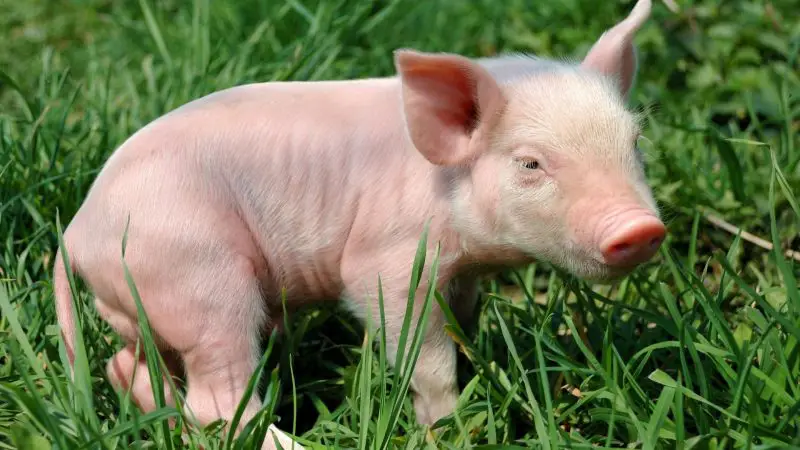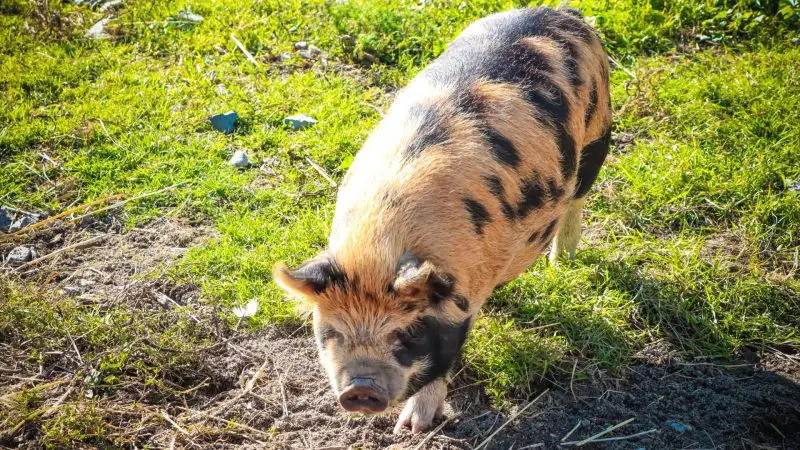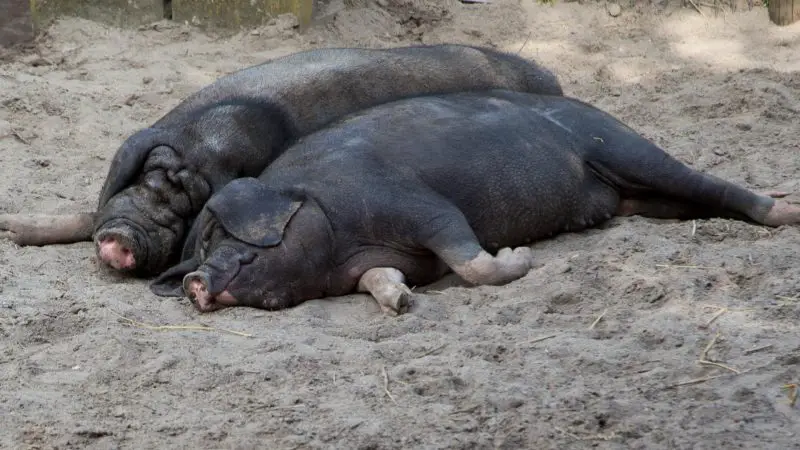Recently, pigs’ popularity as pets has increased, due to their intelligent, cute, and friendly nature. On top of that, they can be trained to do basic tricks, like dogs.
But, what small pig breeds will make you smile? There are several breeds of small pigs, and some of them are:
- Kunekune—is one of the smallest breeds of pigs. They’re odorless and can grow up to 24 inches.
- Pot Bellied Pigs—are an extremely smart breed of pigs. They’re highly trainable and look so adorable with the loose skin that gives them a wrinkled look. This breed can grow 14 to 20 inches in height.
The two pigs above are only some of the breeds that you can choose from.
What Are Small Pig Breeds?

Small pig breeds are adorable, curious, extra friendly, and social miniature pigs. They’re either kept as pets or raised for their tender meats.
These pigs originated from Asia and were brought to Canada, then to the United States. Most breeds have small, perked ears, chubby bodies, and short noses.
When it comes to food, they enjoy eating maize, cassava, soya beans, and rice bran.
9 Small Pig Breeds That Will Make You Smile
Small pig breeds are especially popular as pets and for their tender, juicy meat. Due to these reasons, many people have been hooked on having their miniature pigs as pets or raising them for their meat.
So, if you’re one of those who are currently looking for the right small pig breed, some options you have are:
Kunekune

- Appearance: Kunekune pigs are generally fat with a rounded appearance. They can be distinguished by their short legs, pot tummy, and upturned muzzle.
- Size: 24 inches in height (mature), 130 and 440 lb (mature weight)
- Color: Tricolor (black, white, gold)
- Place of origin: Asia
- Characteristics: Upturned short nose, short-legged, rounded bodies, friendly but can be aggressive, highly trainable, and very intelligent.
The Kunekune breed is deemed as the smallest out of all the small pigs’ breeds. They have a brown, black, gold, and white tail tip.
Furthermore, this breed is known for its friendly and docile nature, making it one of the most sought-after pig breeds as pets. The Kunekune pig is well-covered with either straight or curly hair.
One thing to note about these pigs is that they won’t do well indoors because they’re so used to their natural habitat (woodland and pasture). However, you can still make them as outdoor pets. Moreover, the Kunekune pigs prefer to graze on grass over food scraps or pig’s commercial food.
Mulefoot Pig
- Appearance: The Mulefoot pigs are typically black in color with some white spots, which are quite rare. They also have some wattles on their neck but aren’t so common.
- Size: 36 to 42 inches in height (mature) 400 to 600 pounds (mature weight)
- Color: Black
- Place of origin: Spain
- Characteristics: Straight floppy ears, long nose, and short ears, medium-sized, rare white markings
The Mulfoot pig breed is currently at its critical level, with the annual registration number dropping to 200 in the U.S as of 2006. They can be identified with their straight floppy ears, long nose, and short ears.
In general, Mulefoot is kept for their lean meats. The females of this breed are devoted mothers and take good care of their newborns until reaching maturity.
Juliana
- Appearance: The Juliana pigs resemble a lot like the feral pigs, but a smaller version. They possess colorful spots that make them unique and adorable.
- Size: 10 to 16 inches in height (mature), 20 to 40 pounds (mature weight)
- Color: Silver, rust, black, red, or white-colored body
- Place of origin: Europe and Asia
- Characteristics: Spotted bodies, long muzzle
Juliana pigs are also called small painted pigs and have either white, black, or red. These pigs resemble a small version of a feral pig. Furthermore, the bodies of Juliana pigs are lean and are typically 16 inches tall.
American Mini Pig
- Appearance: The American mini pig species have compact bodies and are smaller than other breeds. They possess varied colors and markings, making them unique from other small pig breeds.
- Size: 15 to 20 inches in height, 50-150 pounds (full-grown weight)
- Color: Possess a variety of colors, such as white, dotted with black or golden brown spots.
- Place of origin: U.S.
- Characteristics: Highly intelligent, trainable, mild-tempered, friendly, possess thicker coats, swayed backs, and come in various colors.
The American mini pig species are crossbreeds and are smaller in stature compared to other breeds. These pigs are approximately 15 to 20 inches, making them perfect pets for pig lovers.
Furthermore, the pigs under this breed are mild-tempered, friendly, intelligent, and highly trainable. On top of that, they also have strong, straight legs and compacted bodies.
They’re called by several adorable names, such as micro-pigs, teacup pigs, and pocket pigs. Like most other breeds of pigs, they can live up to 20 years and are known for their love for carrots, cucumbers, zucchini, and pumpkins.
Ossabaw Island Hog
- Appearance: The pigs under this breed are typically small, possessing pricked ears, long noses, and heavy coats.
- Size: 20 inches in height (mature), 100-150 pounds (mature weight)
- Color: Spotted black
- Place of origin: Spain
- Characteristics: Intelligent, friendly, long muzzles, erect ears, and a dense coat of bristles
The Ossabaw Island hogs are critically endangered species from the feral pigs’ population on Ossabaw Island, Georgia, United States. They’re descendants of Spanish pigs that were brought 400,000 years ago to the New World.
Although some of these pigs have escaped and become feral, they never mixed with domesticated pigs, just like most ferals. They stayed distinct, which reflects their Spanish ancestry closely.
Meishan

- Appearance: They can be recognized by their large drooping dangling ears and wrinkled, dark black skin.
- Size: 23 inches in height (mature), 350-400 pounds (mature weight)
- Color: Black
- Place of origin: China
- Characteristics: Medium-sized, black skin, dangling ears, densely wrinkled thick skin
The Meishan breeds are miniature pigs named after China’s province. These pigs have been in demand due to their tender and flavorful meat.
Furthermore, they are strong and valued for their superior fat quality and juicy meat. This breed can last up to 15 to 20 years.
Yucatan Breed
- Appearance: They’re black, hairless pigs with large erect ears and possess short to medium bodies.
- Size: 18-26 inches in height (mature), 134 pounds (mature weight)
- Color: Black
- Place of origin: Mexico
- Characteristics: Erect large ears, short fat body, medium to long hairless tails
The Yucatan breed is docile and extremely active miniature pigs that originated in Mexico. They’re hairless, slate-gray, and used to regular human contact that lets them tolerate restraint.
This breed has been raised in the Yucatan Peninsula for five centuries and is used in tropical climates. In addition, the pigs under this breed are skilled at walking on rocky terrains and are resistant to diseases.
American Guinea Hog
- Appearance: The Guinea hogs possess curly tails, erect ears, and sturdy, medium-sized bodies with black hairs. Moreover, their backs are slightly arched and stout.
- Size: 22-27 inches in height (mature), 300 pounds (mature weight)
- Color: Solid black
- Place of origin: United States
- Characteristics: Friendly, stout, medium-sized, solid black bodies
The American guinea hogs are an endangered breed of pigs due to the pet pig craze that happened in the 1990s, which caused them to stop breeding. They’re mostly chosen by pet pig lovers because of their particular small stature and friendliness.
Pot Bellied Pigs

- Appearance: The pigs under this breed have straight tails, long muzzles, and erect ears.
- Size: 14-20 inches in height (mature), 70-150 pounds (mature weight)
- Color: Black
- Place of origin: Vietnam
- Characteristics: Charming, intelligent, possess long nose, straight tails, and upright ears.
The Pot bellied pigs are charming, intelligent, affectionate, and curious breed pigs. However, at first, this breed tends to be hard to handle compared to other breeds.
They can’t be tamed and dislike being carried by humans. However, when you get along with them—which requires time, they can get attached to you.
Frequently Asked Questions
Do Pigs Bite?
Pigs are very capable of biting. However, biting incidents are rare. It only happens when they’re being mistreated or abused.
Is Pig a Dirty Animal?
Despite pigs’ reputation of being called ‘dirty animals,’ they’re clean animals because they don’t poop near their eating or sleeping area. They got this ‘filthy reputation’ due to their obsession with rolling off in the mud—which is needed because it’s their way of cooling themselves.
What Is the Most Expensive Pig Breed?
The black Iberian pig is the most expensive pig breed. It’s reported that the rear leg of this breed can cost $4,500.
This pig breed is located in the Western and Southern regions of the Iberian Peninsula, which covers Spain and Portugal.
Do Pigs Love Their Owners?
Pigs are extremely affectionate and social animals. They’re capable of forming special bonds with people, most especially their owners, and long for their companionship.
In other words, pigs do love their owners and desire their company. They like getting petted because they feel adored and appreciated in such a manner.
Do Pigs Recognize Their Names?
Pigs can recognize their names if trained well. If you’ve got pigs, you can start the training when they’re as young as two to three weeks old.
Summary
Pigs are adorable, intelligent, and highly trainable animals that can be petted. They’re comparable to dogs when it comes to being affectionate and warm.
Thus, it’s not a surprise that many people are drawn to having pigs as their pets. If you’re planning to get one as a pet, you can choose the breed listed in this article to help you decide which one you like the best.
List of Sources
Kunekune. (1998). Oklahoma State University.
Burke, T. W. (1993). Pot bellied pigs. U.S. Department of Justice – Office of Justice Programs.
Ossabaw Island hog. Smithsonian’s National Zoo & Conservation Biology Institute.
